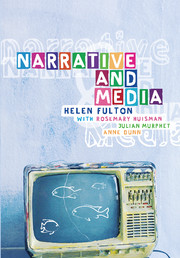Book contents
- Frontmatter
- Contents
- Figures and tables
- Contributors
- Acknowledgements
- 1 Introduction: the power of narrative
- Part 1 The basics of narrative theory
- Part 2 Film as narrative and visual mode
- Part 3 Television: narratives and ideology
- 10 The genres of television
- 11 Television news as narrative
- 12 Aspects of narrative in series and serials
- 13 Soap operas and sitcoms
- Part 4 Radio and print journalism
- Part 5 Popular print culture
- Glossary
- Bibliography
- Index
10 - The genres of television
Published online by Cambridge University Press: 05 June 2012
- Frontmatter
- Contents
- Figures and tables
- Contributors
- Acknowledgements
- 1 Introduction: the power of narrative
- Part 1 The basics of narrative theory
- Part 2 Film as narrative and visual mode
- Part 3 Television: narratives and ideology
- 10 The genres of television
- 11 Television news as narrative
- 12 Aspects of narrative in series and serials
- 13 Soap operas and sitcoms
- Part 4 Radio and print journalism
- Part 5 Popular print culture
- Glossary
- Bibliography
- Index
Summary
Each medium develops its own ways of telling stories. These different ways of telling stories encompass the devices of the plot, the technical aspects of the medium, and the codes and conventions of types of stories. Another way of putting this, which employs terms you will have encountered in earlier chapters, is that different media allow different possibilities of diegesis (telling the story) and mimesis (performance) and the relation between the two. Whether as readers (audiences) of texts or as producers of them, we recognise these combinations and categorise them, in order to advise or predict what kind of story this is going to be.
These categories of story may be identified as genres (the French word for types or kinds). On the one hand, genres can be seen as offering an important way of framing texts that assists comprehension. Genre knowledge orientates competent readers towards appropriate attitudes, assumptions and expectations about a text, which are useful in making sense of it. On the other hand, genres may be seen ideologically, as constraining interpretation, as limiting the available meanings of the text. What is a genre? Texts concerned with the study of television, such as Williams (1990), Tulloch (2000) or Creeber (2001), offer genres (or forms, as Williams calls them) of television program, such as news, drama, ‘variety’, sport, advertising, ‘cop series’, soap opera, documentary, cartoons, situation comedy, children's television and ‘popular entertainment’. Some of these are broken down still further by Creeber (2001).
- Type
- Chapter
- Information
- Narrative and Media , pp. 125 - 139Publisher: Cambridge University PressPrint publication year: 2005



